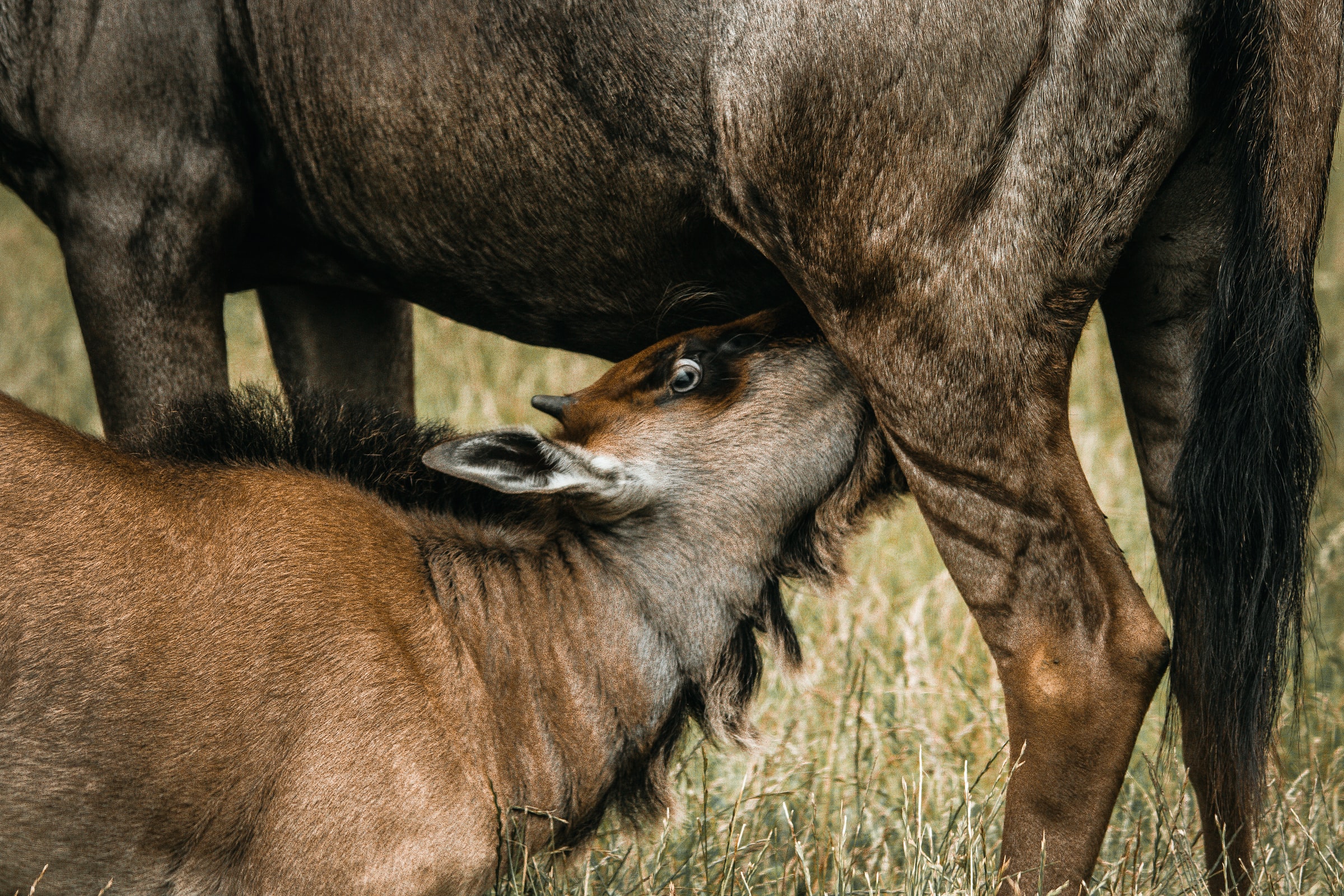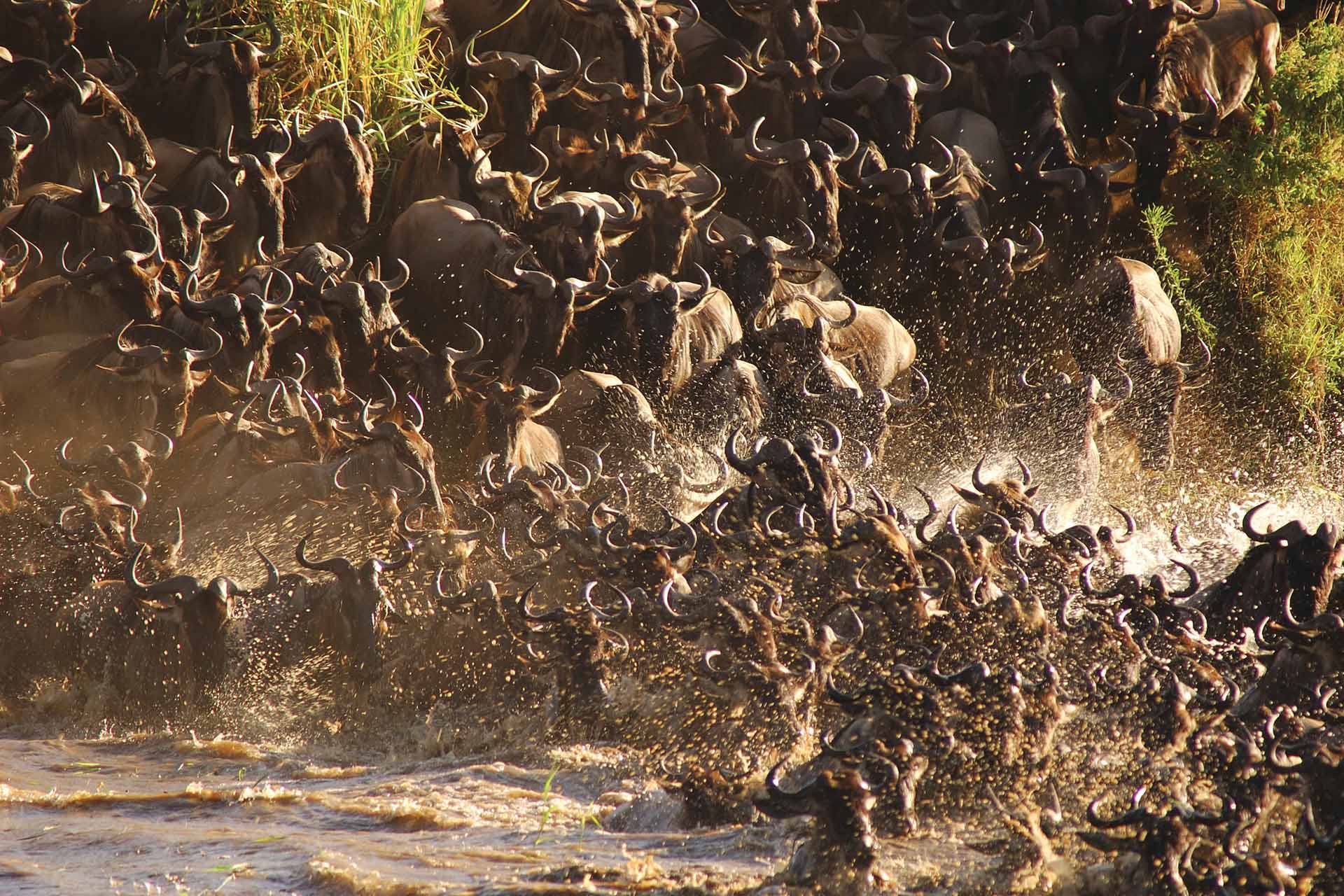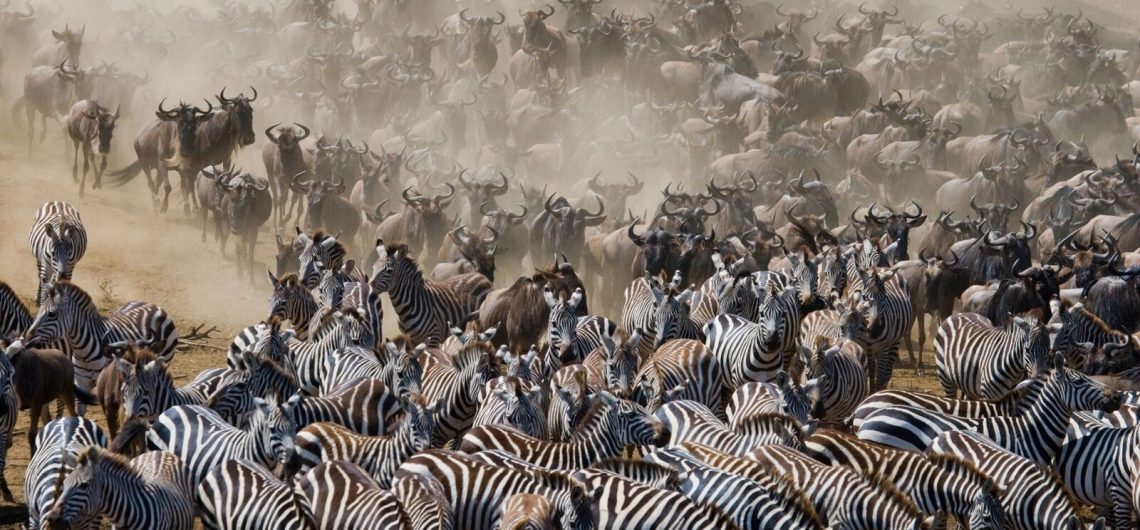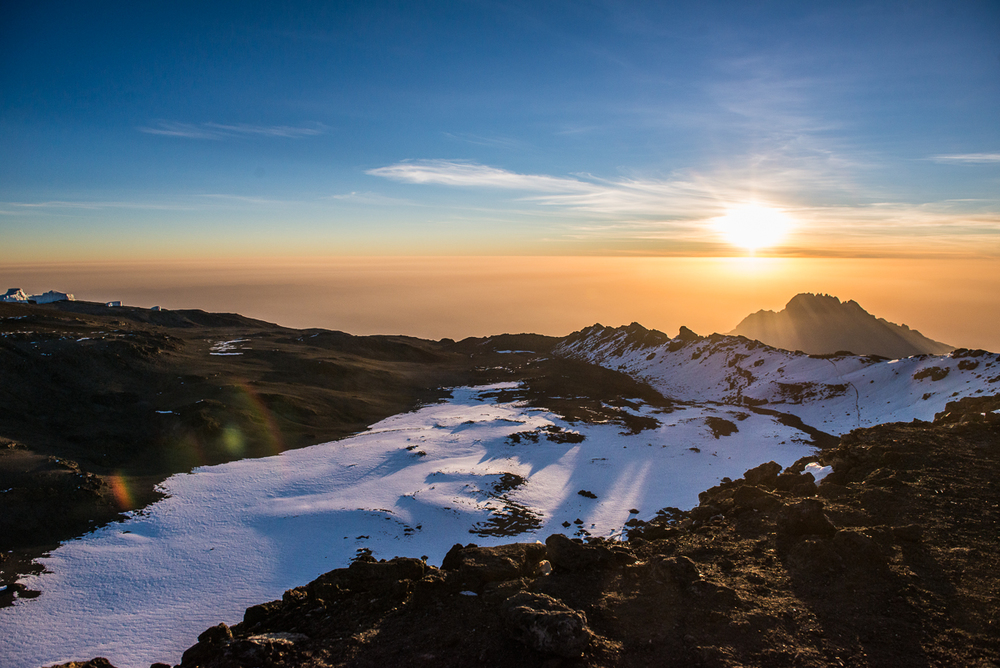The best time for climbing Mount Kilimanjaro and at the same time witnessing one of the greatest spectacles on earth, the great wildebeest migration is during the dry seasons, which typically occur from late June to October and from January to around mid-March. These months offer clear skies, lower precipitation, and more stable weather conditions, providing optimal trekking conditions and higher chances of summit success.
For safaris in Tanzania, including witnessing the wildebeest migration in the Serengeti, the timing varies depending on the specific wildlife viewing experiences you seek:
- Wildebeest Migration: The Great Migration, one of Africa’s most spectacular wildlife events, typically occurs from July to October. During this time, millions of wildebeest, zebras, and other herbivores migrate across the Serengeti plains in search of greener pastures, making it an ideal time for witnessing dramatic river crossings and predator-prey interactions.
- Dry Season: The dry season, from June to October, is considered the best time for wildlife viewing in Tanzania’s national parks, including the Serengeti, Tarangire, and Ngorongoro Crater. With vegetation becoming sparse and animals gathering around water sources, sightings of lions and other predators, elephants, giraffes, and other iconic species are more frequent.
- Calving Season: From January to March, the calving season occurs in the southern Serengeti and Ndutu area, attracting predators like lions and cheetahs in search of vulnerable prey. Witnessing the spectacle of thousands of wildebeest calves being born amidst the vast plains is a highlight of this period.
In the rainy months, the mountain is often obscured by a thick mist which can make the trek very wet and the summit very cold and snow-covered. The rain often improves the views, but it can also make the trek very muddy and the rain may result in turning back before reaching the summit. For consideration of weather and views, the best compromise would be a trip made between January to mid-March and July to mid-October. The clearest view periods usually coincide with the cool and warm weather, so you should also consider which season is best for yourself and how important summit views are.
As with the majority of the popular trekking nations like Australia and Nepal, Tanzania lacks a very definitive answer for the “best” time of year to visit. The climate and weather of Mount Kilimanjaro is kind of unpredictable and change greatly within the different climate zones, and the best time for something will be the worst for others. Our suggestion is not fine-tuned for the weather (assuming you’re not wanting to trek in a snowstorm), but it aims to provide the best compromise between getting good views whilst avoiding the majority of the rain. The two trekking “high seasons” are late December to early March and July – October. These are the times of the dry seasons and will often offer only light rain between long periods of sunny skies.
See our great wildebeest migration safaris
- 6 Day Wildebeest Calving season & Migration Safari in Ndutu – Serengeti
- 7-Day Great Wildebeest Migration Safari in the Western & Central Serengeti
- 8 Days Ndutu & Wildebeest Calving Season Safari
- 9 Days Wildebeest Migration Crossing, August to October
- 10 days Mara river crossing & Great Wildebeest migration, Serengeti safari
- So what is the best time to conquer Kilimanjaro and follow the wildebeest migration?
As you may be aware from our article dubbed “best time to climb Kilimanjaro” which also coincides with the best time to see the great wildebeest migration. The warm and dry season (January-March) and the cool and dry season (June-October are the best times for this trip. Below is a month-to-month guide of when is the ideal time to climb Kilimanjaro and then go on a great wildebeest migration safari.
January to March (Calving season)

January
The southern plains, stretching from Moru to Naabi, Kusini, and Ndutu, witness the gathering of wildebeest. These grassy lands are particularly fertile, with high levels of phosphorus and magnesium provided by the volcanic ash present in the calcrete layer beneath the shallow soil. It is advisable to pack waterproof gear, as the region experiences occasional intense thunderstorms. However, if you are fortunate, you may have the opportunity to witness some early wildebeest calving.
February
In the month of February, when calving season reaches its highest point, it is truly a remarkable sight to witness hundreds of thousands of freshly born wildebeests bravely taking their initial strides amidst a backdrop of motionless herds. These precious moments can be observed across the vast expanse of the Ndutu and Kusini plains, extending towards the majestic Ngorongoro Highlands. Despite being the driest period during the rainy season, intermittent and scarce rainfall still graces the surroundings.
March
As the calving season nears its conclusion, the herds remain mostly stationary in the Ndutu-Kusini vicinity. However, a few animals venture even farther south into Maswa and eastward towards Namiri Plains, which is known for its abundance of predators. It is advised to keep your camera close in this prime wildlife area. The final few wildebeest calves come into the world amidst the intense thunderstorms that often occur in the region.
June to October (River crossing)
 June
June
The Great Migration is in full swing, travelling swiftly up through the Western Corridor and Grumeti Reserve. It’s peak rutting time, as well as the beginning of the dry season, though there are still localised showers in the north. From now on, the animals’ nutrition depends largely on the growth stage of the Digitaria, Pennisetum, Eustachys and Themeda grasses anchored in nutrient-rich clay amid the woodlands.
For wildebeest, the grass really is greener on the other side — of the Mara and Sand rivers, that is. Crossings are the stuff nature documentaries are made of, and a stay at Sayari means you’re perfectly positioned to catch the action. The head of the herd will have reached the Kogatende area in the northern Serengeti, ready to cross the Mara and Sand rivers, complete with hungry crocodiles lurking in the water.
For the most part, herds will cross south to north, drawn by the more nutritious grazing on the northern side thanks to earlier showers. However, some crossings also occur in the opposite direction. For spectacular sightings of the bulk of the wildebeest herds, interspersed with dazzles of zebra and herds of antelope, head to the Lamai Wedge and Nyamalumbwa Plains.
River traffic flows in both directions between Kenya and Tanzania in September, though a southerly direction will prevail by the end of the month. This treacherous traverse is one of nature’s greatest and most tragic spectacles, and tens of thousands of animals will die in the attempt. The rains remain absent in the south, with sparse showers still occurring in the north.
The tail end of the herd crosses the river from Kenya down into Tanzania, as thunderstorms begin in the north. Meanwhile, the bulk of the animals are moving back down into the Lobo Valley region and Grumeti Reserve, tracing their epic annual circle back south toward their calving grounds.
Best Time for Kilimanjaro
Due to the great height variations on Kilimanjaro, each zone experienced quite different weather. Generally, the temperatures drop by 6.5°C for every 1000m you gain as you ascend. As the mountain is close to the equator, the temperatures are quite steady around the year. The only significant amount of precipitation in the area falls from March to May – these are the rainiest months. The long rains can be experienced from early to mid-March to the beginning of June and the short rains from November to early December. This should be taken into account as rain can be expected in these periods. The rainforest zone can receive up to 2000mm annually. The rainforest is succeeded by the heath zone where the temperatures are moderate and precipitation is at a medium level. The heath zone is followed by the somewhat inhospitable moorland zone where vegetation is limited and temperatures can drop below freezing. Even the moorland zone still receives quite a bit of rainfall. High-altitude alpine conditions prevail in the next zone nearing the peak. This is where the temperatures start to become quite severe and precipitation diminishes. At the coldest time, temperatures can range to -7°C and it can snow any day of the year. During a hot day, thick snow and ice can melt and run down into the next zone, causing the only real hazardous weather condition on the mountain – rock fall due to slippery surface caused by melted ice running over frozen ice. This has been more of a problem recently due to the shrinking glaciers. On the whole, temperatures at the summit do not rise above freezing all year. The best times to look at from a weather perspective would be in the warmest months with the least chance of misty or rainy weather. From the heath zone upwards, this weather is found from early December to the end of February and also the whole of September. So from a weather perspective, these periods are the best times to climb the mountain. You can read more about the best time to climb Kilimanjaro here.
 Weather Conditions
Weather Conditions
Due to the fact that Kilimanjaro is close to the equator, this mountain does not experience the extremes of winter and summer weather, but rather dry and wet seasons. It can rain anytime of year, but there is usually one long rain season and a shorter rain season. The driest months on Kilimanjaro are usually July-October and January-March. The warmest months are December to March, with temperatures on the lower slopes ranging from 25°C during the day to 10°C at night. These are also the most ideal months for climbing, though you can expect sub-zero temperatures at night and the possibility of rain and snow at all times of year. The wettest months are March, April and November. During the wettest months, trekkers may have to contend with mud and a lack of visibility. Throughout the year, the mountain is subjected to 5 different ecological zones. The lower slopes are a cultivated zone, with many farms and villages. About 1000m up is the rainforest zone, where most of Kilimanjaro’s animals are viewed. Then crops up the heath zone, which leads to the alpine desert and ultimately an arctic climate. All this should be taken into account when planning your trek, but if you want a more detailed analysis of the weather during your particular month of travel, then Kilimanjaro Climbing and the Eco-System has a very comprehensive guide.
Peak Season
The climb is possible year round, but the best season is from late June to the end of October, and from December to the end of March. During the dry seasons in July-October and January-March, there is a lower risk of being exposed to the elements, and it is considered easier to enjoy the mountain and more likely to reach the summit. The best weather is generally in the first dry season, particularly in late June-July. This is the tail end of the rainy season, so the mountain is relatively clear of hikers and the mountain is lush and green. Unfortunately, as it is still the wintertime in Europe and N. America, this is also the most expensive time to travel to Tanzania. There may be light snow down to 4500m, but not enough to greatly impact the hiking trail. Even if it does snow, it will usually melt the following day. The main issue with the clear weather in early June-July is that it corresponds with the Serengeti migration and is the high season for the safari parks in Tanzania. Safari tours and national parks can become crowded and accommodations may be more difficult to book. Later in the June-October season, the weather is drier but colder and the higher likelihood of clear weather is more offset by colder temperatures. In September and October, daytime temperatures will be close to those on the summit but it will be colder at night. This is a good time for those who want to combine the climb with a safari, and for wildlife enthusiasts. Any of the dry season months are a good time for a Kilimanjaro climb. The next best season is the first part of the short dry season in December. Unfortunately, this is also a high travel time for the North American and European Christmas and New Year holidays.
Off-Peak Season
Accommodation: Many budget operators will still be running climbs as to maintain reliable work source and improve staff training. But it will be the larger companies trying to secure their share of what is now a smaller market that will be willing to operate at a loss for a short time, pinch business off their rivals, and offer discounts to secure future business from new clients and dissatisfied clients of their competitors. So even though there will be a few companies slightly lowering their standards to get by, the increased competition can mean the best varied choice of operator for potential climbers. This is also a time to keep an eye out for some short time special offers. Although it is not advised to take low quality of climb or little known company for the sake of a discount, there are rare occurrences when a good company that usually may seem overpriced can offer to fill a few empty places at a lower cost.
There has been an increasing strike and protests around Kenya and Tanzania wildlife parks have increased the taxes on the park fees. This has persuaded an increasing number of safari operators to bid packages of northern Tanzania and Kenya safaris. Also, the main reasons prices are lower have been explained: lodges do not get fully booked and companies are eager to have clients at this quieter time of year. With all this, there has been an increase in marketing of “green seasons” safaris from April, late May, and November into early December. So if you are flexible with your time, you may consider these times. This green season marketing is primarily to do with the safaris as these are times where there may be big discounts for lodges and best availability for the same reasons, but it can of course apply to Kilimanjaro also. An increase in the viability of climbing Kilimanjaro March-May for quieter mountain and limited time offers, for this is now considered the “off season” for Kili.
Best Time for Safari in Tanzania
The major downside of the popular northern circuit parks is that they can be very busy with tourists, especially during the peak seasons. If you’re looking for a more private safari experience in these parks, it might be best to go off the beaten track and arrange your tour during the shoulder seasons. Overall, the best time for a safari in Tanzania is during the dry season and just after, from late June up to October, or from December to early January. If you’re hoping to see the wildebeest migration at its peak, you’ll have to time your trip around this and book far in advance.
However, the best months for safaris in general are usually considered to be June through September, since it is winter in the southern hemisphere and the temperatures are comfortable. Another high season for safaris is from December to February, during the warmest time of the year in Tanzania. The animals are more difficult to spot since they are more dispersed during this time, but the landscape is at its most beautiful, with the western circuit parks and the southern circuit parks at their most stunning.
Wildebeest Migration
It is worth noting that the migration is a continuous event, so it is hard to pin down the exact location of the animals at a specific time. If you are visiting the Serengeti and do not want to see the river crossing, then the migration can be seen all year round as the animals move in a circular motion in search of food and water. From December to April, the majority of the animals are usually located in the Southern Serengeti and the Ndutu region.
The wildebeest migration is one of the most astounding sights, and it has to be one of the best times to be on a safari in Tanzania. The migration consists of almost 2 million animals, predominantly wildebeest but also zebra and various species of antelope. They migrate from the Serengeti National Park in Tanzania to the Maasai Mara National Reserve in Kenya in search of greener pastures. This can best be seen around May when the animals start to move northwest through the Western Corridor and across the Grumeti River. The most dramatic part of the migration is when the animals have to cross the Mara River, and it is here that you can witness a dramatic river crossing. This is the most popular time to be in the Serengeti and/or the Maasai Mara, so it is best to book accommodation well in advance.
Dry Season
Basically, the rain is the deciding factor on the quality of game viewing, as it can either make it an incredible experience or a damp squib. During the peak of the wet season, some of the lodges and camps are closed, as the dirt roads become impassable and the quality of game viewing is reduced. So if money is no object, the best time to visit Tanzania would be twice; first in January or February and again in July to October. However, do be warned that the prices are higher and some areas – such as the Ngorongoro Conservation Area – become so touristy that it can feel like peak season still.
Lastly, if you are interested in seeing the rare animals, they tend to be quite scarce in the national parks which are off the beaten track for tourists. To give an example, the oryx and gerenuk are much easier to spot in the Selous Game Reserve, due to the fact that there are far fewer vehicles around and the animals are not as shy and elusive. In Tarangire National Park, the dry season is the best time to visit as the wildlife viewing is at its prime and the bird watching is exceptional.
If the migration isn’t of large concern, the best time for the safari would be the dry season. During that time, the animals are much easier to find since they concentrate around the remaining water sources. With there being less vegetation around the waterholes and rivers, it makes game viewing easier. The dry season is between June to October. This is the best time to visit the parks. There is little chance of rain, and the weather is pleasant and not too hot, with temperatures ranging between 20 and 30°C. This is also the time when most European and North American visitors come to Tanzania, so it can be the tourist high season.
Wet Season
Your best bet for seeing the big wildebeest river crossings in the Serengeti is a week or two in January or February, typically the short dry season in Tanzania. River crossings can occur sporadically any time from June to September, depending on the rains, but the most likely time is usually a two-week period in late January and early February. It’s during this time that the herds gather in the southern Serengeti. With some luck, they’ll find the courage to take the plunge and cross the croc-infested waters of the Grumeti River. We can arrange it so that you stay a few nights in the Serengeti and a few nights in the Ngorongoro Conservation Area (NCAA), as the wildebeest are in the south but often come up to the short grass plains of the NCAA before crossing the river. A night or two between January and March in a mobile camp in the Ndutu area would also be ideal, as it’s the area where the wildebeest are calving. However – and this is a big however – weather patterns can change and the migration may move quickly. Despite last year’s weather pattern, we are told that the current weather pattern is now normal and 2017 should be a normal wet season – grain of salt.
![]()


 Weather Conditions
Weather Conditions